Fiona Ingram's Blog, page 37
November 15, 2015
Book Blast: Book Elves Anthology Vol. 2
Mother Daughter Book Reviews is pleased to be coordinating a Book Blast for the second volume of the "BookElves Anthology" featuring some of your favorite middle grade authors. Now available - just in time for the holiday season!

About the BookTitle: BookElves Anthology, Volume 2 | Authors: Jemima Pett, Cheryl Carpinello, Rebecca M. Douglass, Wendy Leighton-Porter, S.W. Lothian, Annaliese Matheron, Ben Zackheim | Publication Date: November 12, 2015 | Publisher: Princelings Publications | Pages: 176 | Recommended Ages: 8 to 14 Summary: Seven authors, seven new tales to twang your heartstrings as you snuggle up cosy and warm during the long winter nights. Will the Christmas fairy be ready to grant your wishes? Will Shirley Link solve all the clues to her presents? Will a keen inventor steal the heart of a lady? Will another lady have her life saved by a horse? And will Santa's reindeer, a lost and forlorn hero, and a boy under the spell of a wicked witch find their way home when they are left out in the cold at midwinter? Find out in this second anthology from the MG BookElves, a selection that older children will love, and adults will enjoy reading to younger children.
Shirley Link's friends help her rediscover the joy of Christmas by setting her musical puzzles to solve - and with her detective skills, maybe she's the only one who can! Ben Zackheim (Shirley Link Detective Series, the Camelot Kids)Max the talking Tonkinese cat has an unpleasant surprise when he finds himself trapped in the attic one night and, while pondering his escape, discovers that he’s not alone. Help comes from a rather unexpected quarter … and the Twelve Days of Christmas will never seem quite the same again! Wendy Leighton-Porter (The Shadows from the Past series)Not only does Melvin Finklestein plan to impress his peers with his brilliant cracker at the Beverly Hills College of Gifted Inventors Xmas Reunion Spectacular, he’s determined to win the heart of the wonderful Trixie Tragik. What could possibly go wrong? S W Lothian (The Quest series, Time Square series)If you found a lost reindeer in the woods, could you hide him away long enough for him regain his ability to fly? Find out who else Dougall meets when he befriends Reinhardt the reindeer. Jemima Pett (The Princelings of the East series)Halitor can't find the people who need his help on the long night of Midwinter. But they find him, and there may be some holiday magic in the air. Rebecca M Douglass (The Ninja Librarian series, Halitor the Hero)Once this warhorse carried a mighty king; now he carries a cargo more precious - the young girl destined to be his queen. Cheryl Carpinello (Young Knights of King Arthur series, Young Guinevere)The Witch War is over, but the scars of their spells still cause havoc in Werifesteria, even King Aldridge is affected. When Jacob’s father is taken by the witch of The Dark Wood he and the king set out on a quest to return him. A fun fairy-tale adventure by Annaliese Matheron (Ninja Nan series) Each tale weaves its own seasonal magic. Each magician has already warmed the hearts of thousands of young readers with their stories. Enjoy these frantic races to meet the Christmas deadline while you curl up in your favourite reading spot this winter.
Amazon (Print) * Amazon (Kindle) * Amazon (UK)Smashwords * iTunes * B&N * Kobo * Goodreads
About the Authors: Cheryl Carpinello is a retired high school English teacher. A devourer of books growing up, her profession introduced her to writings and authors from times long past. Through her studies and teaching, she fell in love with the Ancient and Medieval Worlds. Now, she hopes to inspire young readers to read more through her Quest Books set in these worlds. Website: http://carpinelloswritingpages.blogspot.com
Cheryl Carpinello is a retired high school English teacher. A devourer of books growing up, her profession introduced her to writings and authors from times long past. Through her studies and teaching, she fell in love with the Ancient and Medieval Worlds. Now, she hopes to inspire young readers to read more through her Quest Books set in these worlds. Website: http://carpinelloswritingpages.blogspot.com  Rebecca M. Douglass has been reading and writing stories since she was old enough to hold a pencil. She has a special fondness for fantasy thanks to childhood visits to Narnia and Middle Earth. Ms. Douglass uses her word-processor near San Francisco, CA, where she lives with her husband and two teenage sons, while her imagination runs where it will, in this world and out. She is the author of the beloved Ninja Librarian books, as well as a picture book for outdoor families, a mystery for the parents, and of course the middle-grade fantasy, Halitor the Hero. Website: http://ninjalibrarian.com
Rebecca M. Douglass has been reading and writing stories since she was old enough to hold a pencil. She has a special fondness for fantasy thanks to childhood visits to Narnia and Middle Earth. Ms. Douglass uses her word-processor near San Francisco, CA, where she lives with her husband and two teenage sons, while her imagination runs where it will, in this world and out. She is the author of the beloved Ninja Librarian books, as well as a picture book for outdoor families, a mystery for the parents, and of course the middle-grade fantasy, Halitor the Hero. Website: http://ninjalibrarian.com  Wendy Leighton-Porter devotes her time to writing books for children after 20 years of teaching French, Latin and Classical studies. Shadows from the Past is a series of time-travel adventure stories, featuring three children and a rather special Tonkinese cat. She lives in France and Abu Dhabi, and is currently working on the ninth book in the series,
The Shadow of the Tudor Rose
. Website: http://www.wendy-leighton-porter.com
Wendy Leighton-Porter devotes her time to writing books for children after 20 years of teaching French, Latin and Classical studies. Shadows from the Past is a series of time-travel adventure stories, featuring three children and a rather special Tonkinese cat. She lives in France and Abu Dhabi, and is currently working on the ninth book in the series,
The Shadow of the Tudor Rose
. Website: http://www.wendy-leighton-porter.com 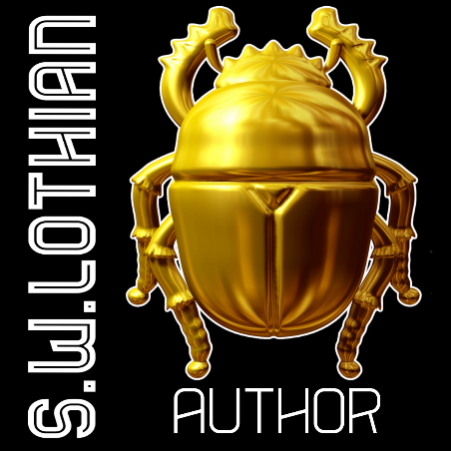 S.W. Lothian is the creator of edge-of-your-seat time-travel adventures that provide thrills for all ages. From his sun-drenched home in Australia he pens exciting books that launch readers into epic settings filled with amazing action. Great characters, mystery, and humour make a broth of irresistible tales. Through recent personal experience, S.W. has become a passionate advocate of raising awareness of Childhood Cancer. Improved awareness leads to increased research, which hopefully will lead to a cure. Website: http://swlothian.com
S.W. Lothian is the creator of edge-of-your-seat time-travel adventures that provide thrills for all ages. From his sun-drenched home in Australia he pens exciting books that launch readers into epic settings filled with amazing action. Great characters, mystery, and humour make a broth of irresistible tales. Through recent personal experience, S.W. has become a passionate advocate of raising awareness of Childhood Cancer. Improved awareness leads to increased research, which hopefully will lead to a cure. Website: http://swlothian.com  Unlike many authors Annaliese Matheron never knew what she wanted to be. She wanted to do a million and one different things – be an ice-skater, or an archaeologist, or an astrophysicist, or a theatre director – luckily she realised that by being an author she could be all these things and more. Annaliese now spends her time making stuff up and writing it down. Her humorous adventure story
Ninja Nan and Sidekick Grandad
was a finalist in the 2013 People’s Book Prize. Website: http://annaliesematheron.com
Unlike many authors Annaliese Matheron never knew what she wanted to be. She wanted to do a million and one different things – be an ice-skater, or an archaeologist, or an astrophysicist, or a theatre director – luckily she realised that by being an author she could be all these things and more. Annaliese now spends her time making stuff up and writing it down. Her humorous adventure story
Ninja Nan and Sidekick Grandad
was a finalist in the 2013 People’s Book Prize. Website: http://annaliesematheron.com  Jemima Pett lives in a three-bedroom red-brick castle surrounded by water, along with her guinea pigs, the inspiration for brain-twisting The Princelings of the East. She writes their adventures as fast as she can, but sometimes writes science fiction adventures about asteroid miners and their friends instead. She lives in Norfolk, writes in UK English and occasionally in US English or double Dutch. Website: http://jemimapett.com
Jemima Pett lives in a three-bedroom red-brick castle surrounded by water, along with her guinea pigs, the inspiration for brain-twisting The Princelings of the East. She writes their adventures as fast as she can, but sometimes writes science fiction adventures about asteroid miners and their friends instead. She lives in Norfolk, writes in UK English and occasionally in US English or double Dutch. Website: http://jemimapett.com
 Ben Zackheim started writing Shirley Link in 2011 and hasn't stopped since. He's up to book five in the series, which will be titled
Shirley Link & The Party Poopers
. He lives in Massachusetts, at 42.5098° N, 72.6995° W, surrounded by the Forbidden Forest, with his wife and son. Website: http://benzackheim.com
Ben Zackheim started writing Shirley Link in 2011 and hasn't stopped since. He's up to book five in the series, which will be titled
Shirley Link & The Party Poopers
. He lives in Massachusetts, at 42.5098° N, 72.6995° W, surrounded by the Forbidden Forest, with his wife and son. Website: http://benzackheim.com
Follow the MG BookElves on Facebook: http://facebook.com/mgbookelves and elsewhere using #MGBookElves.Please also give your support to the other MG BookElves not included in this year's Anthology: * Melanie Abed * Julie Anne Grasso * Paul Hewlett * Fiona Ingram * M G King * S. Smith
Goodreads GiveawayPrize: 2 copies of the "BookElves Anthology, Volume 2", the paperback edition, worldwide. Open: Worldwide Giveaway Ends: Nov 26 2015
Goodreads Book Giveaway BookElves Anthology Volume 2by Jemima PettGiveaway ends November 26, 2015. See the giveaway detailsat Goodreads. Enter Giveaway
BookElves Anthology Volume 2by Jemima PettGiveaway ends November 26, 2015. See the giveaway detailsat Goodreads. Enter Giveaway
** Book Blast Giveaway **Prize: One winner will receive a $25 Amazon gift card or $25 PayPal cash prize, winner's choice Giveaway ends: November 26, 11:59 pm, 2015 Open to: Internationally How to enter: Please enter using the Rafflecopter widget below. Terms and Conditions: NO PURCHASE NECESSARY TO ENTER OR WIN. VOID WHERE PROHIBITED BY LAW. A winner will be randomly drawn through the Rafflecopter widget and will be contacted by email within 48 hours after the giveaway ends. The winner will then have 72 hours to respond. If the winner does not respond within 72 hours, a new draw will take place for a new winner. Odds of winning will vary depending on the number of eligible entries received. This contest is in no way sponsored, endorsed or administered by, or associated with Facebook. This giveaway is sponsored by the authors of the BookElves Anthology, Volume 2 and is hosted and managed by Renee from Mother Daughter Book Reviews. If you have any additional questions – feel free to send an email to Renee(at)MotherDaughterBookReviews(dot)com. a Rafflecopter giveaway

About the BookTitle: BookElves Anthology, Volume 2 | Authors: Jemima Pett, Cheryl Carpinello, Rebecca M. Douglass, Wendy Leighton-Porter, S.W. Lothian, Annaliese Matheron, Ben Zackheim | Publication Date: November 12, 2015 | Publisher: Princelings Publications | Pages: 176 | Recommended Ages: 8 to 14 Summary: Seven authors, seven new tales to twang your heartstrings as you snuggle up cosy and warm during the long winter nights. Will the Christmas fairy be ready to grant your wishes? Will Shirley Link solve all the clues to her presents? Will a keen inventor steal the heart of a lady? Will another lady have her life saved by a horse? And will Santa's reindeer, a lost and forlorn hero, and a boy under the spell of a wicked witch find their way home when they are left out in the cold at midwinter? Find out in this second anthology from the MG BookElves, a selection that older children will love, and adults will enjoy reading to younger children.
Shirley Link's friends help her rediscover the joy of Christmas by setting her musical puzzles to solve - and with her detective skills, maybe she's the only one who can! Ben Zackheim (Shirley Link Detective Series, the Camelot Kids)Max the talking Tonkinese cat has an unpleasant surprise when he finds himself trapped in the attic one night and, while pondering his escape, discovers that he’s not alone. Help comes from a rather unexpected quarter … and the Twelve Days of Christmas will never seem quite the same again! Wendy Leighton-Porter (The Shadows from the Past series)Not only does Melvin Finklestein plan to impress his peers with his brilliant cracker at the Beverly Hills College of Gifted Inventors Xmas Reunion Spectacular, he’s determined to win the heart of the wonderful Trixie Tragik. What could possibly go wrong? S W Lothian (The Quest series, Time Square series)If you found a lost reindeer in the woods, could you hide him away long enough for him regain his ability to fly? Find out who else Dougall meets when he befriends Reinhardt the reindeer. Jemima Pett (The Princelings of the East series)Halitor can't find the people who need his help on the long night of Midwinter. But they find him, and there may be some holiday magic in the air. Rebecca M Douglass (The Ninja Librarian series, Halitor the Hero)Once this warhorse carried a mighty king; now he carries a cargo more precious - the young girl destined to be his queen. Cheryl Carpinello (Young Knights of King Arthur series, Young Guinevere)The Witch War is over, but the scars of their spells still cause havoc in Werifesteria, even King Aldridge is affected. When Jacob’s father is taken by the witch of The Dark Wood he and the king set out on a quest to return him. A fun fairy-tale adventure by Annaliese Matheron (Ninja Nan series) Each tale weaves its own seasonal magic. Each magician has already warmed the hearts of thousands of young readers with their stories. Enjoy these frantic races to meet the Christmas deadline while you curl up in your favourite reading spot this winter.
Amazon (Print) * Amazon (Kindle) * Amazon (UK)Smashwords * iTunes * B&N * Kobo * Goodreads
About the Authors:
 Cheryl Carpinello is a retired high school English teacher. A devourer of books growing up, her profession introduced her to writings and authors from times long past. Through her studies and teaching, she fell in love with the Ancient and Medieval Worlds. Now, she hopes to inspire young readers to read more through her Quest Books set in these worlds. Website: http://carpinelloswritingpages.blogspot.com
Cheryl Carpinello is a retired high school English teacher. A devourer of books growing up, her profession introduced her to writings and authors from times long past. Through her studies and teaching, she fell in love with the Ancient and Medieval Worlds. Now, she hopes to inspire young readers to read more through her Quest Books set in these worlds. Website: http://carpinelloswritingpages.blogspot.com  Rebecca M. Douglass has been reading and writing stories since she was old enough to hold a pencil. She has a special fondness for fantasy thanks to childhood visits to Narnia and Middle Earth. Ms. Douglass uses her word-processor near San Francisco, CA, where she lives with her husband and two teenage sons, while her imagination runs where it will, in this world and out. She is the author of the beloved Ninja Librarian books, as well as a picture book for outdoor families, a mystery for the parents, and of course the middle-grade fantasy, Halitor the Hero. Website: http://ninjalibrarian.com
Rebecca M. Douglass has been reading and writing stories since she was old enough to hold a pencil. She has a special fondness for fantasy thanks to childhood visits to Narnia and Middle Earth. Ms. Douglass uses her word-processor near San Francisco, CA, where she lives with her husband and two teenage sons, while her imagination runs where it will, in this world and out. She is the author of the beloved Ninja Librarian books, as well as a picture book for outdoor families, a mystery for the parents, and of course the middle-grade fantasy, Halitor the Hero. Website: http://ninjalibrarian.com  Wendy Leighton-Porter devotes her time to writing books for children after 20 years of teaching French, Latin and Classical studies. Shadows from the Past is a series of time-travel adventure stories, featuring three children and a rather special Tonkinese cat. She lives in France and Abu Dhabi, and is currently working on the ninth book in the series,
The Shadow of the Tudor Rose
. Website: http://www.wendy-leighton-porter.com
Wendy Leighton-Porter devotes her time to writing books for children after 20 years of teaching French, Latin and Classical studies. Shadows from the Past is a series of time-travel adventure stories, featuring three children and a rather special Tonkinese cat. She lives in France and Abu Dhabi, and is currently working on the ninth book in the series,
The Shadow of the Tudor Rose
. Website: http://www.wendy-leighton-porter.com  S.W. Lothian is the creator of edge-of-your-seat time-travel adventures that provide thrills for all ages. From his sun-drenched home in Australia he pens exciting books that launch readers into epic settings filled with amazing action. Great characters, mystery, and humour make a broth of irresistible tales. Through recent personal experience, S.W. has become a passionate advocate of raising awareness of Childhood Cancer. Improved awareness leads to increased research, which hopefully will lead to a cure. Website: http://swlothian.com
S.W. Lothian is the creator of edge-of-your-seat time-travel adventures that provide thrills for all ages. From his sun-drenched home in Australia he pens exciting books that launch readers into epic settings filled with amazing action. Great characters, mystery, and humour make a broth of irresistible tales. Through recent personal experience, S.W. has become a passionate advocate of raising awareness of Childhood Cancer. Improved awareness leads to increased research, which hopefully will lead to a cure. Website: http://swlothian.com  Unlike many authors Annaliese Matheron never knew what she wanted to be. She wanted to do a million and one different things – be an ice-skater, or an archaeologist, or an astrophysicist, or a theatre director – luckily she realised that by being an author she could be all these things and more. Annaliese now spends her time making stuff up and writing it down. Her humorous adventure story
Ninja Nan and Sidekick Grandad
was a finalist in the 2013 People’s Book Prize. Website: http://annaliesematheron.com
Unlike many authors Annaliese Matheron never knew what she wanted to be. She wanted to do a million and one different things – be an ice-skater, or an archaeologist, or an astrophysicist, or a theatre director – luckily she realised that by being an author she could be all these things and more. Annaliese now spends her time making stuff up and writing it down. Her humorous adventure story
Ninja Nan and Sidekick Grandad
was a finalist in the 2013 People’s Book Prize. Website: http://annaliesematheron.com  Jemima Pett lives in a three-bedroom red-brick castle surrounded by water, along with her guinea pigs, the inspiration for brain-twisting The Princelings of the East. She writes their adventures as fast as she can, but sometimes writes science fiction adventures about asteroid miners and their friends instead. She lives in Norfolk, writes in UK English and occasionally in US English or double Dutch. Website: http://jemimapett.com
Jemima Pett lives in a three-bedroom red-brick castle surrounded by water, along with her guinea pigs, the inspiration for brain-twisting The Princelings of the East. She writes their adventures as fast as she can, but sometimes writes science fiction adventures about asteroid miners and their friends instead. She lives in Norfolk, writes in UK English and occasionally in US English or double Dutch. Website: http://jemimapett.com
 Ben Zackheim started writing Shirley Link in 2011 and hasn't stopped since. He's up to book five in the series, which will be titled
Shirley Link & The Party Poopers
. He lives in Massachusetts, at 42.5098° N, 72.6995° W, surrounded by the Forbidden Forest, with his wife and son. Website: http://benzackheim.com
Ben Zackheim started writing Shirley Link in 2011 and hasn't stopped since. He's up to book five in the series, which will be titled
Shirley Link & The Party Poopers
. He lives in Massachusetts, at 42.5098° N, 72.6995° W, surrounded by the Forbidden Forest, with his wife and son. Website: http://benzackheim.com Follow the MG BookElves on Facebook: http://facebook.com/mgbookelves and elsewhere using #MGBookElves.Please also give your support to the other MG BookElves not included in this year's Anthology: * Melanie Abed * Julie Anne Grasso * Paul Hewlett * Fiona Ingram * M G King * S. Smith
Goodreads GiveawayPrize: 2 copies of the "BookElves Anthology, Volume 2", the paperback edition, worldwide. Open: Worldwide Giveaway Ends: Nov 26 2015
Goodreads Book Giveaway
 BookElves Anthology Volume 2by Jemima PettGiveaway ends November 26, 2015. See the giveaway detailsat Goodreads. Enter Giveaway
BookElves Anthology Volume 2by Jemima PettGiveaway ends November 26, 2015. See the giveaway detailsat Goodreads. Enter Giveaway ** Book Blast Giveaway **Prize: One winner will receive a $25 Amazon gift card or $25 PayPal cash prize, winner's choice Giveaway ends: November 26, 11:59 pm, 2015 Open to: Internationally How to enter: Please enter using the Rafflecopter widget below. Terms and Conditions: NO PURCHASE NECESSARY TO ENTER OR WIN. VOID WHERE PROHIBITED BY LAW. A winner will be randomly drawn through the Rafflecopter widget and will be contacted by email within 48 hours after the giveaway ends. The winner will then have 72 hours to respond. If the winner does not respond within 72 hours, a new draw will take place for a new winner. Odds of winning will vary depending on the number of eligible entries received. This contest is in no way sponsored, endorsed or administered by, or associated with Facebook. This giveaway is sponsored by the authors of the BookElves Anthology, Volume 2 and is hosted and managed by Renee from Mother Daughter Book Reviews. If you have any additional questions – feel free to send an email to Renee(at)MotherDaughterBookReviews(dot)com. a Rafflecopter giveaway

Published on November 15, 2015 22:38
November 12, 2015
Book Blast: The Ifs
Mother Daughter Book Reviews is pleased to be coordinating a Book Blast for the middle grade book series "The Ifs" by J.D. Pooker (November 12 to 14, 2015).

About the Books Title: The Ifs | Author: J.D. Pooker | Illustrator: Frank Walls | Publication Date: April 22, 2013 | Publisher: Little Devil Books | Pages: 146 | Recommended Ages: 8 to 12 Summary: Landon and Broden are brothers. And some days they DO NOT get along very well. They spend most of their days fighting, arguing and plotting ways to get revenge on each other. Then, strange things start happening…
Title: The Ifs | Author: J.D. Pooker | Illustrator: Frank Walls | Publication Date: April 22, 2013 | Publisher: Little Devil Books | Pages: 146 | Recommended Ages: 8 to 12 Summary: Landon and Broden are brothers. And some days they DO NOT get along very well. They spend most of their days fighting, arguing and plotting ways to get revenge on each other. Then, strange things start happening…
Noises in their room that are not the cat.Homework is mysteriously finished.A broken shoelace repairs all by itself.Clothes are put in the hamper on their own. The brothers want to share their weird experiences, but they don’t know if they can trust each other. But when they find out who’s behind all the strange things around the house, they are called to battle. Battle? Whoa! Right there in the forest by their house! A battle with the most unusual creatures and wildest of beasts. And when the battle turns more dangerous than they imagined, Landon and Broden must face their fears, put their grudges aside and learn how to work together.
The brothers want to share their weird experiences, but they don’t know if they can trust each other. But when they find out who’s behind all the strange things around the house, they are called to battle. Battle? Whoa! Right there in the forest by their house! A battle with the most unusual creatures and wildest of beasts. And when the battle turns more dangerous than they imagined, Landon and Broden must face their fears, put their grudges aside and learn how to work together.

Title: The Ifs Return | Author: J.D. Pooker | Illustrator: Frank Walls | Publication Date: May 17, 2015 | Publisher: Little Devil Books | Pages: 131 | Recommended Ages: 8 to 12 Summary: “Gage escaped.” These are the worst words Broden could hear from his big brother Landon—just one day after they battled alongside Slade’s Ifs and his army of forest beasts. Sure, the brothers had learned to work together to fight and capture the evil If Gage. But, now, Slade has informed them that Gage has escaped! Fear and distrust have entered the boys’ world. Why should they help Slade if he can’t keep control of his prisoners? Will they be able to fight against a familiar foe? Plus, Landon has more news… “Gage has magic.” What kind of magic? Will he use it against them? As the boys are drawn into yet more adventure with the Ifs, they find out just how powerful, and dangerous, Gage’s magic can be.
The Buzz About the Books CLICK HERE TO READ EXCERPTS OF REVIEWS FROM "THE IFS" BOOK REVIEW BLITZ The Ifs: "A good and exciting read for a middle school age child. I like the message this story projected, brothers no matter what!" ~ 1977 Books The Ifs: "I am in love with this book!. Action packed, adventurous and thrilling!" ~ Naznin Azeez The Ifs: "This book is packed full of mystery, adventure, action and some brotherly love. It’s a fun read and will be enjoyed by both girls and boys." ~ Stitch Says CLICK HERE TO READ EXCERPTS OF REVIEWS FROM "THE IFS RETURN" BOOK REVIEW BLITZ The Ifs Return: "This book is very exciting.Children and up would absolutely love this book. I’m ready for book 3!" ~ Jane Ritz The Ifs Return: "There is a lot of quick paced action which children enjoy. The characters are great and ones your kids can relate to as well. I recommend that you check out The Ifs books if your kids enjoy a good adventure." ~ Christy’s Cozy Corners The Ifs Return: "Summed up, this is a fun adventure for kids ages 8+ which will send their fantasy on a wild ride and make the search for a hidden tiny fold adventure of their own." ~ Bookworm for Kids
About the Author: J.D. Pooker J.D. POOKER lives in wonderful Wyoming with her husband and two sons, along with a black lab named Ryder and a sweet kitty named Alia. J.D. likes to spend time with her family and go camping, fishing, and snowmobiling. Her sons, Landon and Broden, were the inspiration for The Ifs and The Ifs Return. The brothers enjoy camping, fishing, and snowmobiling with their parents. They also enjoy wrestling, playing with their Wii, their toy guns and bows and arrows, and their pets. J.D. can’t wait until her boys get older. She is sure they will have many fabulous adventures.
J.D. POOKER lives in wonderful Wyoming with her husband and two sons, along with a black lab named Ryder and a sweet kitty named Alia. J.D. likes to spend time with her family and go camping, fishing, and snowmobiling. Her sons, Landon and Broden, were the inspiration for The Ifs and The Ifs Return. The brothers enjoy camping, fishing, and snowmobiling with their parents. They also enjoy wrestling, playing with their Wii, their toy guns and bows and arrows, and their pets. J.D. can’t wait until her boys get older. She is sure they will have many fabulous adventures.
Website
** Book Blast Giveaway **Prize: One winner will receive a $25 Amazon gift card or $25 PayPal cash prize, winner's choice Giveaway ends: November 25, 11:59 pm, 2015 Open to: Internationally How to enter: Please enter using the Rafflecopter widget below. Terms and Conditions: NO PURCHASE NECESSARY TO ENTER OR WIN. VOID WHERE PROHIBITED BY LAW. A winner will be randomly drawn through the Rafflecopter widget and will be contacted by email within 48 hours after the giveaway ends. The winner will then have 72 hours to respond. If the winner does not respond within 72 hours, a new draw will take place for a new winner. Odds of winning will vary depending on the number of eligible entries received. This contest is in no way sponsored, endorsed or administered by, or associated with Facebook. This giveaway is sponsored by J.D. Pooker and is hosted and managed by Renee from Mother Daughter Book Reviews. If you have any additional questions – feel free to send and email to Renee(at)MotherDaughterBookReviews(dot)com. a Rafflecopter giveaway

About the Books
 Title: The Ifs | Author: J.D. Pooker | Illustrator: Frank Walls | Publication Date: April 22, 2013 | Publisher: Little Devil Books | Pages: 146 | Recommended Ages: 8 to 12 Summary: Landon and Broden are brothers. And some days they DO NOT get along very well. They spend most of their days fighting, arguing and plotting ways to get revenge on each other. Then, strange things start happening…
Title: The Ifs | Author: J.D. Pooker | Illustrator: Frank Walls | Publication Date: April 22, 2013 | Publisher: Little Devil Books | Pages: 146 | Recommended Ages: 8 to 12 Summary: Landon and Broden are brothers. And some days they DO NOT get along very well. They spend most of their days fighting, arguing and plotting ways to get revenge on each other. Then, strange things start happening… Noises in their room that are not the cat.Homework is mysteriously finished.A broken shoelace repairs all by itself.Clothes are put in the hamper on their own.
 The brothers want to share their weird experiences, but they don’t know if they can trust each other. But when they find out who’s behind all the strange things around the house, they are called to battle. Battle? Whoa! Right there in the forest by their house! A battle with the most unusual creatures and wildest of beasts. And when the battle turns more dangerous than they imagined, Landon and Broden must face their fears, put their grudges aside and learn how to work together.
The brothers want to share their weird experiences, but they don’t know if they can trust each other. But when they find out who’s behind all the strange things around the house, they are called to battle. Battle? Whoa! Right there in the forest by their house! A battle with the most unusual creatures and wildest of beasts. And when the battle turns more dangerous than they imagined, Landon and Broden must face their fears, put their grudges aside and learn how to work together.

Title: The Ifs Return | Author: J.D. Pooker | Illustrator: Frank Walls | Publication Date: May 17, 2015 | Publisher: Little Devil Books | Pages: 131 | Recommended Ages: 8 to 12 Summary: “Gage escaped.” These are the worst words Broden could hear from his big brother Landon—just one day after they battled alongside Slade’s Ifs and his army of forest beasts. Sure, the brothers had learned to work together to fight and capture the evil If Gage. But, now, Slade has informed them that Gage has escaped! Fear and distrust have entered the boys’ world. Why should they help Slade if he can’t keep control of his prisoners? Will they be able to fight against a familiar foe? Plus, Landon has more news… “Gage has magic.” What kind of magic? Will he use it against them? As the boys are drawn into yet more adventure with the Ifs, they find out just how powerful, and dangerous, Gage’s magic can be.

The Buzz About the Books CLICK HERE TO READ EXCERPTS OF REVIEWS FROM "THE IFS" BOOK REVIEW BLITZ The Ifs: "A good and exciting read for a middle school age child. I like the message this story projected, brothers no matter what!" ~ 1977 Books The Ifs: "I am in love with this book!. Action packed, adventurous and thrilling!" ~ Naznin Azeez The Ifs: "This book is packed full of mystery, adventure, action and some brotherly love. It’s a fun read and will be enjoyed by both girls and boys." ~ Stitch Says CLICK HERE TO READ EXCERPTS OF REVIEWS FROM "THE IFS RETURN" BOOK REVIEW BLITZ The Ifs Return: "This book is very exciting.Children and up would absolutely love this book. I’m ready for book 3!" ~ Jane Ritz The Ifs Return: "There is a lot of quick paced action which children enjoy. The characters are great and ones your kids can relate to as well. I recommend that you check out The Ifs books if your kids enjoy a good adventure." ~ Christy’s Cozy Corners The Ifs Return: "Summed up, this is a fun adventure for kids ages 8+ which will send their fantasy on a wild ride and make the search for a hidden tiny fold adventure of their own." ~ Bookworm for Kids
About the Author: J.D. Pooker
 J.D. POOKER lives in wonderful Wyoming with her husband and two sons, along with a black lab named Ryder and a sweet kitty named Alia. J.D. likes to spend time with her family and go camping, fishing, and snowmobiling. Her sons, Landon and Broden, were the inspiration for The Ifs and The Ifs Return. The brothers enjoy camping, fishing, and snowmobiling with their parents. They also enjoy wrestling, playing with their Wii, their toy guns and bows and arrows, and their pets. J.D. can’t wait until her boys get older. She is sure they will have many fabulous adventures.
J.D. POOKER lives in wonderful Wyoming with her husband and two sons, along with a black lab named Ryder and a sweet kitty named Alia. J.D. likes to spend time with her family and go camping, fishing, and snowmobiling. Her sons, Landon and Broden, were the inspiration for The Ifs and The Ifs Return. The brothers enjoy camping, fishing, and snowmobiling with their parents. They also enjoy wrestling, playing with their Wii, their toy guns and bows and arrows, and their pets. J.D. can’t wait until her boys get older. She is sure they will have many fabulous adventures. Website
** Book Blast Giveaway **Prize: One winner will receive a $25 Amazon gift card or $25 PayPal cash prize, winner's choice Giveaway ends: November 25, 11:59 pm, 2015 Open to: Internationally How to enter: Please enter using the Rafflecopter widget below. Terms and Conditions: NO PURCHASE NECESSARY TO ENTER OR WIN. VOID WHERE PROHIBITED BY LAW. A winner will be randomly drawn through the Rafflecopter widget and will be contacted by email within 48 hours after the giveaway ends. The winner will then have 72 hours to respond. If the winner does not respond within 72 hours, a new draw will take place for a new winner. Odds of winning will vary depending on the number of eligible entries received. This contest is in no way sponsored, endorsed or administered by, or associated with Facebook. This giveaway is sponsored by J.D. Pooker and is hosted and managed by Renee from Mother Daughter Book Reviews. If you have any additional questions – feel free to send and email to Renee(at)MotherDaughterBookReviews(dot)com. a Rafflecopter giveaway

Published on November 12, 2015 21:47
November 8, 2015
Book Blast: The Knights before Christmas
Mother Daughter Book Reviews is pleased to be coordinating a Book Blast for the newly released picture book, "The Knights Before Christmas" by Joan Holub (November 6 to 8, 2015).

About the BookTitle: The Knights Before Christmas | Author: Joan Holub | Illustrator: Scott Magoon | Publication Date: September 8, 2015 | Publisher: Macmillan / Henry Holt | Pages: 32 | Recommended Ages: 4 to 8
Amazon | Barnes & Noble | Books-A-MillionGoodreads | Indiebound | iBook | KoboBook Description:
'Twas December 24th, and three brave knights were just settling in for the night when out on the drawbridge, there arose such a clatter! The knights try everything to get rid of this unknown invader (Santa Claus!), a red and white knight with a fleet of dragons . . .
But nothing would stop their white-whiskered foe. No matter their efforts, he just would not go!This parody of Clement Clarke Moore's well-known poem 'Twas the Night Before Christmas is kid-friendly, clever, and just plain silly. Sure to become a holiday classic of a different kind!
Sneak Peek
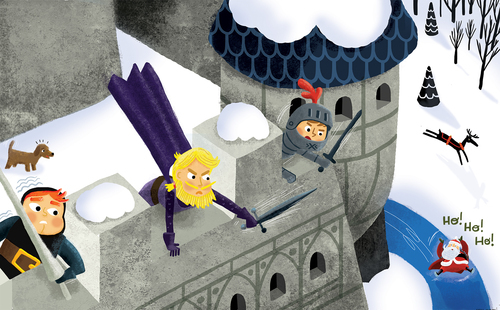
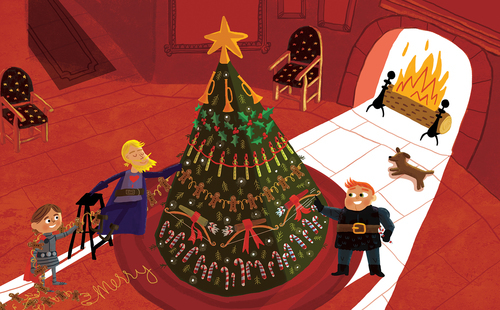
The Buzz About the Book“There's an excellent interplay between the amusing illustrations and the polished text, with lots of clever jokes for readers to discover in the art. These knights know how to keep the castle safe and the readers entertained”~ Kirkus Reviews“A royal romp of holiday pratfalls and punnery. Yule love it!” ~ Tom Lichtenheld, bestselling illustrator of Goodnight, Goodnight Construction Site“A royal delight of a book! Sure to become a favorite holiday read-aloud in every household throughout the land!” ~ Judy Schachner, creator of the bestselling Skippyjon Jones"A great premise...Magoon's illustrations are vibrant and fun...!" ~ Publishers Weekly"This rousing, ridiculous medieval “Night Before Christmas” parody jingles with castle- and holiday wordplay. Cheeky digital illustrations brim with good cheer." ~ Horn Book
About the Author: Joan Holub Joan Holub is the author of 140+ books for children including the acclaimed picture books Little Red Writing, The Knights Before Christmas, and Mighty Dads, a New York Times bestseller. Joan co-authors (with Suzanne Williams) three series: Goddess Girls (ages 8-12, Greek mythology with a middle school twist), Grimmtastic Girls (for ages 8-12, fairy tale adventure with a middle school twist), and Heroes in Training (ages 6-11, Greek mythology adventure chapter books). Watch for her upcoming chapter book, What Was Woodstock?, and her board book, This Little President, both available in early 2016!
Joan Holub is the author of 140+ books for children including the acclaimed picture books Little Red Writing, The Knights Before Christmas, and Mighty Dads, a New York Times bestseller. Joan co-authors (with Suzanne Williams) three series: Goddess Girls (ages 8-12, Greek mythology with a middle school twist), Grimmtastic Girls (for ages 8-12, fairy tale adventure with a middle school twist), and Heroes in Training (ages 6-11, Greek mythology adventure chapter books). Watch for her upcoming chapter book, What Was Woodstock?, and her board book, This Little President, both available in early 2016!
Website | Author Blog | Twitter | Pinterest | GoodreadsFacebook | Facebook (Goddess Girls) | Facebook (Grimmtastic Girls)
** Book Blast Giveaway **Prize: One winner will receive a $25 Amazon gift card or $25 PayPal cash prize, winner's choice Giveaway ends: November 19, 11:59 pm, 2015 Open to: Internationally How to enter: Please enter using the Rafflecopter widget below. Terms and Conditions: NO PURCHASE NECESSARY TO ENTER OR WIN. VOID WHERE PROHIBITED BY LAW. A winner will be randomly drawn through the Rafflecopter widget and will be contacted by email within 48 hours after the giveaway ends. The winner will then have 72 hours to respond. If the winner does not respond within 72 hours, a new draw will take place for a new winner. Odds of winning will vary depending on the number of eligible entries received. This contest is in no way sponsored, endorsed or administered by, or associated with Facebook. This giveaway is sponsored by the author, Joan Holub and is hosted and managed by Renee from Mother Daughter Book Reviews. If you have any additional questions – feel free to send and email to Renee(at)MotherDaughterBookReviews(dot)com. a Rafflecopter giveaway

About the BookTitle: The Knights Before Christmas | Author: Joan Holub | Illustrator: Scott Magoon | Publication Date: September 8, 2015 | Publisher: Macmillan / Henry Holt | Pages: 32 | Recommended Ages: 4 to 8
Amazon | Barnes & Noble | Books-A-MillionGoodreads | Indiebound | iBook | KoboBook Description:
'Twas December 24th, and three brave knights were just settling in for the night when out on the drawbridge, there arose such a clatter! The knights try everything to get rid of this unknown invader (Santa Claus!), a red and white knight with a fleet of dragons . . .
But nothing would stop their white-whiskered foe. No matter their efforts, he just would not go!This parody of Clement Clarke Moore's well-known poem 'Twas the Night Before Christmas is kid-friendly, clever, and just plain silly. Sure to become a holiday classic of a different kind!
Sneak Peek



The Buzz About the Book“There's an excellent interplay between the amusing illustrations and the polished text, with lots of clever jokes for readers to discover in the art. These knights know how to keep the castle safe and the readers entertained”~ Kirkus Reviews“A royal romp of holiday pratfalls and punnery. Yule love it!” ~ Tom Lichtenheld, bestselling illustrator of Goodnight, Goodnight Construction Site“A royal delight of a book! Sure to become a favorite holiday read-aloud in every household throughout the land!” ~ Judy Schachner, creator of the bestselling Skippyjon Jones"A great premise...Magoon's illustrations are vibrant and fun...!" ~ Publishers Weekly"This rousing, ridiculous medieval “Night Before Christmas” parody jingles with castle- and holiday wordplay. Cheeky digital illustrations brim with good cheer." ~ Horn Book
About the Author: Joan Holub
 Joan Holub is the author of 140+ books for children including the acclaimed picture books Little Red Writing, The Knights Before Christmas, and Mighty Dads, a New York Times bestseller. Joan co-authors (with Suzanne Williams) three series: Goddess Girls (ages 8-12, Greek mythology with a middle school twist), Grimmtastic Girls (for ages 8-12, fairy tale adventure with a middle school twist), and Heroes in Training (ages 6-11, Greek mythology adventure chapter books). Watch for her upcoming chapter book, What Was Woodstock?, and her board book, This Little President, both available in early 2016!
Joan Holub is the author of 140+ books for children including the acclaimed picture books Little Red Writing, The Knights Before Christmas, and Mighty Dads, a New York Times bestseller. Joan co-authors (with Suzanne Williams) three series: Goddess Girls (ages 8-12, Greek mythology with a middle school twist), Grimmtastic Girls (for ages 8-12, fairy tale adventure with a middle school twist), and Heroes in Training (ages 6-11, Greek mythology adventure chapter books). Watch for her upcoming chapter book, What Was Woodstock?, and her board book, This Little President, both available in early 2016! Website | Author Blog | Twitter | Pinterest | GoodreadsFacebook | Facebook (Goddess Girls) | Facebook (Grimmtastic Girls)
** Book Blast Giveaway **Prize: One winner will receive a $25 Amazon gift card or $25 PayPal cash prize, winner's choice Giveaway ends: November 19, 11:59 pm, 2015 Open to: Internationally How to enter: Please enter using the Rafflecopter widget below. Terms and Conditions: NO PURCHASE NECESSARY TO ENTER OR WIN. VOID WHERE PROHIBITED BY LAW. A winner will be randomly drawn through the Rafflecopter widget and will be contacted by email within 48 hours after the giveaway ends. The winner will then have 72 hours to respond. If the winner does not respond within 72 hours, a new draw will take place for a new winner. Odds of winning will vary depending on the number of eligible entries received. This contest is in no way sponsored, endorsed or administered by, or associated with Facebook. This giveaway is sponsored by the author, Joan Holub and is hosted and managed by Renee from Mother Daughter Book Reviews. If you have any additional questions – feel free to send and email to Renee(at)MotherDaughterBookReviews(dot)com. a Rafflecopter giveaway

Published on November 08, 2015 05:22
November 7, 2015
Book Blast: The Story Tellers
Mother Daughter Book Reviews is pleased to be coordinating a Book Blast for the newly released middle grade book, "The Storytellers" by Laurisa White Reyes (November 5 to 7, 2015).

About the BookTitle: The Storytellers | Author: Laurisa White Reyes | Publication Date: October , 2015 | Publisher: Skyrocket Press | Pages: 234 | Recommended Ages: 10 to 14 Summary: 12-year-old Elena Barrios' father has AIDS, a new disease in 1991 with a 100% fatality rate. Rather than face certain ridicule and ostracism, Elena tells her friends anything but the truth, fabricating stories about her father being a writer and researcher. But the reality is that Elena resents her father’s illness and can’t face the fact that he is dying. When she is befriended by a woman named Ang who tells stories about her own father, Elena is transported into these stories, allowing her to experience them first hand. With Ang's help, Elena gains the courage to stand up to the bully at her school, mend her relationship with her father, and finally say goodbye.
Amazon (Kindle) * Amazon (Print) * Barnes & Noble * Goodreads
ExcerptElena stood at the street corner, the toes of her sneakers timidly peeking out over the curb. Waves of heat rose from the asphalt, warping the air like water ripples. She took off her glasses and wiped them with a tissue. Then she put them back on. No, it wasn’t her glasses. The air really did seem to move. Elena had never seen that before, not in Idaho where October mornings were cool and crisp. But now the term ‘Sunny California’ made sense to her. It was as hot as a July afternoon back home. She shifted her backpack from one shoulder to the other. Would the light ever turn red, she wondered? This neighborhood was nothing at all like Idaho, everything concrete and brick, the only patch of earth being a vacant lot squeezed in between apartment complexes. And the intersection of Fair Oaks Boulevard and Lake Avenue seemed as wide as the Grand Canyon, with cars zooming past in all directions. Elena wanted to cover her ears and run all the way back to the farm where she had spent her entire life until now, but unfortunately that was something she just could not do. Everywhere Elena looked, there was movement. Across the street in front of a café, a man wearing a white apron around his waist held up a large square of red and white checked fabric. He snapped it in the air before letting it glide down onto a round table. At a florist shop next to the café, a woman arranged bundles of roses and lilies in long, black canisters. Across the street on the opposite corner, a large man with a thick brown mustache stiffly swept the sidewalk in front of a drugstore. And there were people everywhere, men in business suits, women in high heels or active wear, kids with backpacks—everyone walking or jogging or even running. Elena suddenly missed Idaho more than ever. “Off to school, are you?” Elena started. Was someone speaking to her? She glanced around. On the steps of the building next door to Elena’s sat an old woman with skin the darkest shade of brown Elena had ever seen. She wore a flowered bandana tied around her head, and in her hands a strand of yellow yarn twitched between two long, metal needles. Elena wondered what she was making. Mittens? A sweater? No, not in this heat, she thought. The woman looked up from her knitting and spoke again, a little louder than before. Her accent sounded slanted and round, like people who came from the South. “I said are you headin’ off to school?” Elena allowed herself a brief glance in the woman’s direction but then quickly looked back to the street. This was the city after all, and Papi had warned her about strangers. The light turned red and the flow of cars stopped, their engines grumbling and growling like animals pulling against invisible leashes. Elena reached into her pants pocket and pulled out a brown plastic tube the length of her palm. She held the inhaler to her lips and pressed the button on the bottom of the canister. A cool mist filled her lungs. She felt a little better now, but the cars still snarled at her, and the street loomed in front of her like a black void that could swallow her whole. Elena knew she should cross. She would be late to school if she didn’t. There was nothing epic about it, really. She just had to take one step after another. But the longer she waited the harder it was to pry her feet from the curb. “What’cha scared of?” said the woman. Elena felt her staring at the back of her head. “Cars don’t bite, y’know. The way you jus’ standin’ there, you’d think they was a pack of alligators.” The woman was talking to her, but why? What could she possibly want? Elena stiffened. She had to get to school. It was her first day, after all. As she willed herself to step off the curb, she tried to picture her farm and the way the fading daylight cast lacy shadows across the barley fields. She took a deep breath and lifted her foot. Suddenly, the street rippled. Elena leapt back with a start. Scrunching her eyebrows, she peered curiously at the street, which swelled and sloshed like water in a bucket. Then the color of it shifted from black to a sickly shade of green. Elena looked up at the city’s squat concrete buildings with their sharp, straight edges. She watched with astonishment as her new neighborhood, section by section, began to transform—the café, the florist shop, even the apartment buildings all melted into mud, street lamps sprouted leaves and became trees, and where the cars had been appeared the ridged backs of alligators half submerged beneath the murky water. Soon the entire city had vanished, replaced with a hot, humid swamp that smelled of earth and damp moss. Elena listened to the sound of croaking frogs and swatted at a mosquito buzzing in her ear. For a single moment, she forgot about the cars, and the city, and school, and just stared. She was too amazed at her new surroundings to be afraid. Then, curiosity getting the better of her, she dipped the toe of her left sneaker into the water. All of a sudden, a monstrous gray gator sprang up like a giant mousetrap and snapped its tooth-filled jaws, missing her by inches. Elena threw her arms in front of her face and screamed. The frog sounds and the mossy smell vanished, and the all too familiar stench of exhaust fumes filled her nose. Elena lowered her arms. She was back on the corner of Fair Oaks Boulevard, the woman’s knitting needles clicking away. The signal turned green, and the cars at the intersection lurched forward. Elena turned and ran as fast as she could up the front steps to her complex. Then she rushed inside, down the hall to her apartment, and slammed the door shut behind her.
About the Author: Laurisa White Reyes Laurisa White Reyes is the author of The Celestine Chronicles and The Crystal Keeper series. She is also the Editor-in-Chief of Middle Shelf Magazine, a digital publication about books for middle grade readers.
Laurisa White Reyes is the author of The Celestine Chronicles and The Crystal Keeper series. She is also the Editor-in-Chief of Middle Shelf Magazine, a digital publication about books for middle grade readers.
Author Website * Author BlogFacebook * Middle Shelf Magazine
** Book Blast Giveaway **Prize: One winner will receive a $50 Amazon gift card or $50 PayPal cash prize, winner's choice Giveaway ends: November 18, 11:59 pm, 2015 Open to: Internationally How to enter: Please enter using the Rafflecopter widget below. Terms and Conditions: NO PURCHASE NECESSARY TO ENTER OR WIN. VOID WHERE PROHIBITED BY LAW. A winner will be randomly drawn through the Rafflecopter widget and will be contacted by email within 48 hours after the giveaway ends. The winner will then have 72 hours to respond. If the winner does not respond within 72 hours, a new draw will take place for a new winner. Odds of winning will vary depending on the number of eligible entries received. This contest is in no way sponsored, endorsed or administered by, or associated with Facebook. This giveaway is sponsored by the author, Laurisa White Reyes and is hosted and managed by Renee from Mother Daughter Book Reviews. If you have any additional questions – feel free to send and email to Renee(at)MotherDaughterBookReviews(dot)com. a Rafflecopter giveaway

About the BookTitle: The Storytellers | Author: Laurisa White Reyes | Publication Date: October , 2015 | Publisher: Skyrocket Press | Pages: 234 | Recommended Ages: 10 to 14 Summary: 12-year-old Elena Barrios' father has AIDS, a new disease in 1991 with a 100% fatality rate. Rather than face certain ridicule and ostracism, Elena tells her friends anything but the truth, fabricating stories about her father being a writer and researcher. But the reality is that Elena resents her father’s illness and can’t face the fact that he is dying. When she is befriended by a woman named Ang who tells stories about her own father, Elena is transported into these stories, allowing her to experience them first hand. With Ang's help, Elena gains the courage to stand up to the bully at her school, mend her relationship with her father, and finally say goodbye.
Amazon (Kindle) * Amazon (Print) * Barnes & Noble * Goodreads
ExcerptElena stood at the street corner, the toes of her sneakers timidly peeking out over the curb. Waves of heat rose from the asphalt, warping the air like water ripples. She took off her glasses and wiped them with a tissue. Then she put them back on. No, it wasn’t her glasses. The air really did seem to move. Elena had never seen that before, not in Idaho where October mornings were cool and crisp. But now the term ‘Sunny California’ made sense to her. It was as hot as a July afternoon back home. She shifted her backpack from one shoulder to the other. Would the light ever turn red, she wondered? This neighborhood was nothing at all like Idaho, everything concrete and brick, the only patch of earth being a vacant lot squeezed in between apartment complexes. And the intersection of Fair Oaks Boulevard and Lake Avenue seemed as wide as the Grand Canyon, with cars zooming past in all directions. Elena wanted to cover her ears and run all the way back to the farm where she had spent her entire life until now, but unfortunately that was something she just could not do. Everywhere Elena looked, there was movement. Across the street in front of a café, a man wearing a white apron around his waist held up a large square of red and white checked fabric. He snapped it in the air before letting it glide down onto a round table. At a florist shop next to the café, a woman arranged bundles of roses and lilies in long, black canisters. Across the street on the opposite corner, a large man with a thick brown mustache stiffly swept the sidewalk in front of a drugstore. And there were people everywhere, men in business suits, women in high heels or active wear, kids with backpacks—everyone walking or jogging or even running. Elena suddenly missed Idaho more than ever. “Off to school, are you?” Elena started. Was someone speaking to her? She glanced around. On the steps of the building next door to Elena’s sat an old woman with skin the darkest shade of brown Elena had ever seen. She wore a flowered bandana tied around her head, and in her hands a strand of yellow yarn twitched between two long, metal needles. Elena wondered what she was making. Mittens? A sweater? No, not in this heat, she thought. The woman looked up from her knitting and spoke again, a little louder than before. Her accent sounded slanted and round, like people who came from the South. “I said are you headin’ off to school?” Elena allowed herself a brief glance in the woman’s direction but then quickly looked back to the street. This was the city after all, and Papi had warned her about strangers. The light turned red and the flow of cars stopped, their engines grumbling and growling like animals pulling against invisible leashes. Elena reached into her pants pocket and pulled out a brown plastic tube the length of her palm. She held the inhaler to her lips and pressed the button on the bottom of the canister. A cool mist filled her lungs. She felt a little better now, but the cars still snarled at her, and the street loomed in front of her like a black void that could swallow her whole. Elena knew she should cross. She would be late to school if she didn’t. There was nothing epic about it, really. She just had to take one step after another. But the longer she waited the harder it was to pry her feet from the curb. “What’cha scared of?” said the woman. Elena felt her staring at the back of her head. “Cars don’t bite, y’know. The way you jus’ standin’ there, you’d think they was a pack of alligators.” The woman was talking to her, but why? What could she possibly want? Elena stiffened. She had to get to school. It was her first day, after all. As she willed herself to step off the curb, she tried to picture her farm and the way the fading daylight cast lacy shadows across the barley fields. She took a deep breath and lifted her foot. Suddenly, the street rippled. Elena leapt back with a start. Scrunching her eyebrows, she peered curiously at the street, which swelled and sloshed like water in a bucket. Then the color of it shifted from black to a sickly shade of green. Elena looked up at the city’s squat concrete buildings with their sharp, straight edges. She watched with astonishment as her new neighborhood, section by section, began to transform—the café, the florist shop, even the apartment buildings all melted into mud, street lamps sprouted leaves and became trees, and where the cars had been appeared the ridged backs of alligators half submerged beneath the murky water. Soon the entire city had vanished, replaced with a hot, humid swamp that smelled of earth and damp moss. Elena listened to the sound of croaking frogs and swatted at a mosquito buzzing in her ear. For a single moment, she forgot about the cars, and the city, and school, and just stared. She was too amazed at her new surroundings to be afraid. Then, curiosity getting the better of her, she dipped the toe of her left sneaker into the water. All of a sudden, a monstrous gray gator sprang up like a giant mousetrap and snapped its tooth-filled jaws, missing her by inches. Elena threw her arms in front of her face and screamed. The frog sounds and the mossy smell vanished, and the all too familiar stench of exhaust fumes filled her nose. Elena lowered her arms. She was back on the corner of Fair Oaks Boulevard, the woman’s knitting needles clicking away. The signal turned green, and the cars at the intersection lurched forward. Elena turned and ran as fast as she could up the front steps to her complex. Then she rushed inside, down the hall to her apartment, and slammed the door shut behind her.
About the Author: Laurisa White Reyes
 Laurisa White Reyes is the author of The Celestine Chronicles and The Crystal Keeper series. She is also the Editor-in-Chief of Middle Shelf Magazine, a digital publication about books for middle grade readers.
Laurisa White Reyes is the author of The Celestine Chronicles and The Crystal Keeper series. She is also the Editor-in-Chief of Middle Shelf Magazine, a digital publication about books for middle grade readers. Author Website * Author BlogFacebook * Middle Shelf Magazine
** Book Blast Giveaway **Prize: One winner will receive a $50 Amazon gift card or $50 PayPal cash prize, winner's choice Giveaway ends: November 18, 11:59 pm, 2015 Open to: Internationally How to enter: Please enter using the Rafflecopter widget below. Terms and Conditions: NO PURCHASE NECESSARY TO ENTER OR WIN. VOID WHERE PROHIBITED BY LAW. A winner will be randomly drawn through the Rafflecopter widget and will be contacted by email within 48 hours after the giveaway ends. The winner will then have 72 hours to respond. If the winner does not respond within 72 hours, a new draw will take place for a new winner. Odds of winning will vary depending on the number of eligible entries received. This contest is in no way sponsored, endorsed or administered by, or associated with Facebook. This giveaway is sponsored by the author, Laurisa White Reyes and is hosted and managed by Renee from Mother Daughter Book Reviews. If you have any additional questions – feel free to send and email to Renee(at)MotherDaughterBookReviews(dot)com. a Rafflecopter giveaway

Published on November 07, 2015 05:33
November 5, 2015
Book Blast: Bash and Lucy Fetch Confidence
Mother Daughter Book Reviews is pleased to be coordinating a Book Blast for the picture book "Bash and Lucy Fetch Confidence" by the mother-son writing team of Lisa Cohn and Michael Cohn (November 3 to 5, 2015).
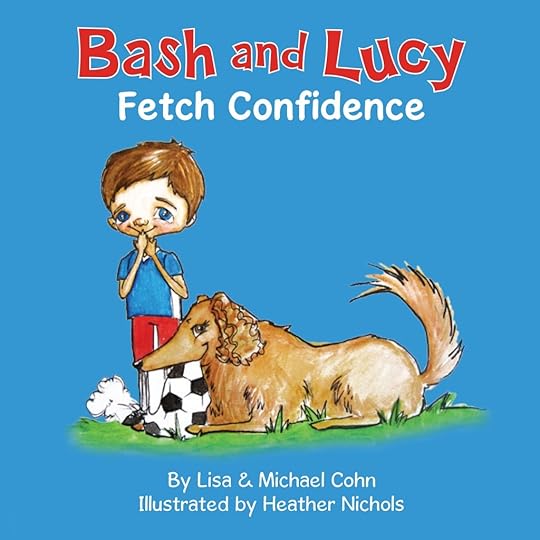
About the BookTitle: Bash and Lucy Fetch Confidence | Authors: Lisa Cohn & Michael Cohn | Publication Date: September 10, 2013 | Publisher: Canines And Kids Publishing | Pages: 34 | Recommended Ages: 3 to 8 Summary: "Bash and Lucy," whose authors were featured on the "Today Show," is a Mom's Choice Silver Award Winner, and Finalist, 2013 USA Best Book Awards. In this contemporary boy-and-dog tale, talkative Bash has a big problem in soccer: His beloved dog, Lucy, is a pro at nabbing the ball, but sometimes at the wrong moment. Coach wants to ban Lucy from soccer practice and games, separating Bash from a companion who boosts his confidence in sports--and life. In this picture book for kids age 4-8, Bash and friends help Coach understand that with Lucy by their side, they feel more confident, laugh more often, and are comforted when they make mistakes. Award-winning author Lisa Cohn and her 5-year-old son (now 7), Michael, wrote the book and started "Michael's Dog Blog" to help overcome their grief over the sudden death of their dog, Lucy. Watch them on the Today Show here: http://www.today.com/video/today/5398...
Amazon (Print) * Audible
The Buzz About the Book“Bash and Lucy,” an endearing story about a boy and his soccer-loving dog, is a book that kids (and the adults who read it to them) will enjoy. Any kid who plays soccer, any parent who’s watched or coached soccer, and anyone who’s loved a dog will find something to love about this book! ~ Susan Moshofsky, teacher, parent, and former soccer mom"Bash and Lucy Fetch Confidence" is a wonderful story that teaches kids and their families about the important relationships we can have with dogs and illustrates beautifully how there can be more than one way to do something...and that the best way isn't always the obvious way! It promotes relationships above results and creative thinking above the status quo. A great read for any dog lovers! ~ Phoebe Spier, Musician and Child/Youth Development ProfessionalIn this charming and humorous tale about a boy and his dog, the authors cleverly show us, through the eyes of the boy and his dog, the beautiful life lessons learned about friendship, love and sportsmanship. Lucy-dog embodies the spirit of teamwork as she builds confidence in a boys’ soccer team and encourages them to work together without saying a word! Age-old values such as respect, love and non-violence punctuate the pages. Young or old, one cannot help but smile at the antics of Lucy and her teammates. Bravo! ~ Laura Stipkala, teacher and parentSuch a cute book…awesome illustrations, too. I really like the idea of using the dog to help teach the concept of teamwork, the importance of confidence, and how the dog represented to the boys these ideas. I also enjoyed the flow of the book…It’s a nice story that can teach some great lessons to kids in sports. ~ Kirk Mango, National Champion, Hall of Famer, & author of “Becoming a True Champion”“Bash & Lucy Fetch Confidence” is a winning picture book that teaches children about the importance of teamwork and sportsmanship while also revealing the close bond between children and their beloved pets..a. great choice for kids age 4-8. ~ Erin MacLellan, author and parent"Bash and Lucy" drives home a valuable lesson -- kids will have the best opportunity to thrive in sports and life if their adult role models provide a comfortable environment that engenders confidence. I highly recommend including this book in your family's bedtime collection." ~ Jack Malley, youth sports coach and author
About the Authors: Lisa Cohn and Michael Cohn Lisa Cohn and her son, Michael, age 7, are co-authors of the "
Bash and Lucy
" book and audiobook series. They have appeared on the Today Show, on SiriusXM Radio, in Disney's Babble, in The Oregonian and other media. Their audiobooks feature the voices of Michael and friends, age 7-10. Lisa and Michael's mission is to share their love of books and dogs. They recently launched
www.RovingReaderLeaders.com
, which features YouTube book reviews by kids, KidLit author interviews by children, and a kids' reading club. You can also visit them at www.BashAndLucy.com.
Lisa Cohn and her son, Michael, age 7, are co-authors of the "
Bash and Lucy
" book and audiobook series. They have appeared on the Today Show, on SiriusXM Radio, in Disney's Babble, in The Oregonian and other media. Their audiobooks feature the voices of Michael and friends, age 7-10. Lisa and Michael's mission is to share their love of books and dogs. They recently launched
www.RovingReaderLeaders.com
, which features YouTube book reviews by kids, KidLit author interviews by children, and a kids' reading club. You can also visit them at www.BashAndLucy.com.
YouTube | Twitter | FacebookGoogle+ | Pinterest | Goodreads
** Book Blast Giveaway **Prize: One winner will receive a $25 Amazon gift card or $25 PayPal cash prize, winner's choice Giveaway ends: November 16, 11:59 pm, 2015 Open to: Internationally How to enter: Please enter using the Rafflecopter widget below. Terms and Conditions: NO PURCHASE NECESSARY TO ENTER OR WIN. VOID WHERE PROHIBITED BY LAW. A winner will be randomly drawn through the Rafflecopter widget and will be contacted by email within 48 hours after the giveaway ends. The winner will then have 72 hours to respond. If the winner does not respond within 72 hours, a new draw will take place for a new winner. Odds of winning will vary depending on the number of eligible entries received. This contest is in no way sponsored, endorsed or administered by, or associated with Facebook. This giveaway is sponsored by Lisa Cohn and is hosted and managed by Renee from Mother Daughter Book Reviews. If you have any additional questions – feel free to send and email to Renee(at)MotherDaughterBookReviews(dot)com. a Rafflecopter giveaway

About the BookTitle: Bash and Lucy Fetch Confidence | Authors: Lisa Cohn & Michael Cohn | Publication Date: September 10, 2013 | Publisher: Canines And Kids Publishing | Pages: 34 | Recommended Ages: 3 to 8 Summary: "Bash and Lucy," whose authors were featured on the "Today Show," is a Mom's Choice Silver Award Winner, and Finalist, 2013 USA Best Book Awards. In this contemporary boy-and-dog tale, talkative Bash has a big problem in soccer: His beloved dog, Lucy, is a pro at nabbing the ball, but sometimes at the wrong moment. Coach wants to ban Lucy from soccer practice and games, separating Bash from a companion who boosts his confidence in sports--and life. In this picture book for kids age 4-8, Bash and friends help Coach understand that with Lucy by their side, they feel more confident, laugh more often, and are comforted when they make mistakes. Award-winning author Lisa Cohn and her 5-year-old son (now 7), Michael, wrote the book and started "Michael's Dog Blog" to help overcome their grief over the sudden death of their dog, Lucy. Watch them on the Today Show here: http://www.today.com/video/today/5398...
Amazon (Print) * Audible
The Buzz About the Book“Bash and Lucy,” an endearing story about a boy and his soccer-loving dog, is a book that kids (and the adults who read it to them) will enjoy. Any kid who plays soccer, any parent who’s watched or coached soccer, and anyone who’s loved a dog will find something to love about this book! ~ Susan Moshofsky, teacher, parent, and former soccer mom"Bash and Lucy Fetch Confidence" is a wonderful story that teaches kids and their families about the important relationships we can have with dogs and illustrates beautifully how there can be more than one way to do something...and that the best way isn't always the obvious way! It promotes relationships above results and creative thinking above the status quo. A great read for any dog lovers! ~ Phoebe Spier, Musician and Child/Youth Development ProfessionalIn this charming and humorous tale about a boy and his dog, the authors cleverly show us, through the eyes of the boy and his dog, the beautiful life lessons learned about friendship, love and sportsmanship. Lucy-dog embodies the spirit of teamwork as she builds confidence in a boys’ soccer team and encourages them to work together without saying a word! Age-old values such as respect, love and non-violence punctuate the pages. Young or old, one cannot help but smile at the antics of Lucy and her teammates. Bravo! ~ Laura Stipkala, teacher and parentSuch a cute book…awesome illustrations, too. I really like the idea of using the dog to help teach the concept of teamwork, the importance of confidence, and how the dog represented to the boys these ideas. I also enjoyed the flow of the book…It’s a nice story that can teach some great lessons to kids in sports. ~ Kirk Mango, National Champion, Hall of Famer, & author of “Becoming a True Champion”“Bash & Lucy Fetch Confidence” is a winning picture book that teaches children about the importance of teamwork and sportsmanship while also revealing the close bond between children and their beloved pets..a. great choice for kids age 4-8. ~ Erin MacLellan, author and parent"Bash and Lucy" drives home a valuable lesson -- kids will have the best opportunity to thrive in sports and life if their adult role models provide a comfortable environment that engenders confidence. I highly recommend including this book in your family's bedtime collection." ~ Jack Malley, youth sports coach and author
About the Authors: Lisa Cohn and Michael Cohn
 Lisa Cohn and her son, Michael, age 7, are co-authors of the "
Bash and Lucy
" book and audiobook series. They have appeared on the Today Show, on SiriusXM Radio, in Disney's Babble, in The Oregonian and other media. Their audiobooks feature the voices of Michael and friends, age 7-10. Lisa and Michael's mission is to share their love of books and dogs. They recently launched
www.RovingReaderLeaders.com
, which features YouTube book reviews by kids, KidLit author interviews by children, and a kids' reading club. You can also visit them at www.BashAndLucy.com.
Lisa Cohn and her son, Michael, age 7, are co-authors of the "
Bash and Lucy
" book and audiobook series. They have appeared on the Today Show, on SiriusXM Radio, in Disney's Babble, in The Oregonian and other media. Their audiobooks feature the voices of Michael and friends, age 7-10. Lisa and Michael's mission is to share their love of books and dogs. They recently launched
www.RovingReaderLeaders.com
, which features YouTube book reviews by kids, KidLit author interviews by children, and a kids' reading club. You can also visit them at www.BashAndLucy.com.YouTube | Twitter | FacebookGoogle+ | Pinterest | Goodreads
** Book Blast Giveaway **Prize: One winner will receive a $25 Amazon gift card or $25 PayPal cash prize, winner's choice Giveaway ends: November 16, 11:59 pm, 2015 Open to: Internationally How to enter: Please enter using the Rafflecopter widget below. Terms and Conditions: NO PURCHASE NECESSARY TO ENTER OR WIN. VOID WHERE PROHIBITED BY LAW. A winner will be randomly drawn through the Rafflecopter widget and will be contacted by email within 48 hours after the giveaway ends. The winner will then have 72 hours to respond. If the winner does not respond within 72 hours, a new draw will take place for a new winner. Odds of winning will vary depending on the number of eligible entries received. This contest is in no way sponsored, endorsed or administered by, or associated with Facebook. This giveaway is sponsored by Lisa Cohn and is hosted and managed by Renee from Mother Daughter Book Reviews. If you have any additional questions – feel free to send and email to Renee(at)MotherDaughterBookReviews(dot)com. a Rafflecopter giveaway

Published on November 05, 2015 07:34
November 4, 2015
Book Blast: Through the Shimmer of Time
Mother Daughter Book Reviews is pleased to be coordinating a Book Blast for the middle grade time-travel thriller "Through the Shimmer of Time" by Jennifer Jensen (November 2 to 4, 2015). Grab an e-copy from Amazon for only 99 cents, November 2 to 4 and for $1.99, November 6 and 7, 2015 (regular price $3.99).


About the BookTitle: Through the Shimmer of Time | Authors: Jennifer Jensen | Publication Date: July 30, 2014Publisher: Pangur Bán Books | Pages: 216 | Recommended Ages: 8 to 12Amazon | GoodreadsBook Description: A little curiosity never hurt anyone, right? When Jim ditches his little sister to search for a haunted cabin, he gets time-traveled nearly 200 years into the past - right into the middle of a swindler's cover-up. The criminals have murder on their minds now, but Jim is trapped in time. Hannah's life of family and farm chores is turned upside down when a boy in strange clothes suddenly appears in the old trapper's cabin. Should she believe his wild tale? And how much will she risk to lay a friend's ghost to rest? Jim and Hannah struggle to unmask a thief and solve a murder, but it will take all their courage and wits, plus the rocket motors in Jim's pocket, just to stay alive. If you love time-travel, mysteries and the olden days, start reading THROUGH THE SHIMMER OF TIME now.
The Buzz About the Book"40 years old and my child inside me could not put it down. This unique writing definately [sic] takes me back to some great stories I have read in my youth. I highly recommend this for anyone that loves time travel." ~ 5 Star Review, CRCurtis, Amazon"The characters and the story are very engaging, and realistic. By the time I was halfway through it, I was a totally believing in time travel! Bravo, Ms. Jensen. Keep up the good work!" ~ 5 Star Review, Kassandra L., Goodreads"This story made me feel like a kid again. I loved mysteries as a child, and even as an adult I gobbled this one up. It's middle-grade, and I think it's perfect for that age group. There's mystery, excitement, a hint of danger, and an annoying little sister (not really, but he thinks she is and don't ALL siblings think that?). It's real life, with time travel twists. Love it. If your child likes mysteries and time adventures, they'll love it." ~ 5 Star Review, Melinda V., Goodreads
About the Author: Jennifer Jensen Jennifer Jensen is an award-winning writer who wouldn’t be without her computer or smart phone, but still dreams of living in the olden days. Until someone invents a working time machine, she lives in Indiana and makes do with plenty of imagination, loads of books and as much Dr. Who as the BBC will produce. She’s a longtime member of SCBWI and has received two Indiana Arts Commission grants for her fiction. Through the Shimmer of Time was her first novel. The sequel, RESCUE Through the Shimmer of Time, will be available for pre-order soon.
Jennifer Jensen is an award-winning writer who wouldn’t be without her computer or smart phone, but still dreams of living in the olden days. Until someone invents a working time machine, she lives in Indiana and makes do with plenty of imagination, loads of books and as much Dr. Who as the BBC will produce. She’s a longtime member of SCBWI and has received two Indiana Arts Commission grants for her fiction. Through the Shimmer of Time was her first novel. The sequel, RESCUE Through the Shimmer of Time, will be available for pre-order soon.
Website | Twitter | Facebook | Google+
** Book Blast Giveaway **Prize: One winner will receive a $25 Amazon gift card or $25 PayPal cash prize, winner's choice Giveaway ends: November 15, 11:59 pm, 2015 Open to: Internationally How to enter: Please enter using the Rafflecopter widget below. Terms and Conditions: NO PURCHASE NECESSARY TO ENTER OR WIN. VOID WHERE PROHIBITED BY LAW. A winner will be randomly drawn through the Rafflecopter widget and will be contacted by email within 48 hours after the giveaway ends. The winner will then have 72 hours to respond. If the winner does not respond within 72 hours, a new draw will take place for a new winner. Odds of winning will vary depending on the number of eligible entries received. This contest is in no way sponsored, endorsed or administered by, or associated with Facebook. This giveaway is sponsored by the author, Jennifer Jensen and is hosted and managed by Renee from Mother Daughter Book Reviews. If you have any additional questions – feel free to send and email to Renee(at)MotherDaughterBookReviews(dot)com. a Rafflecopter giveaway


About the BookTitle: Through the Shimmer of Time | Authors: Jennifer Jensen | Publication Date: July 30, 2014Publisher: Pangur Bán Books | Pages: 216 | Recommended Ages: 8 to 12Amazon | GoodreadsBook Description: A little curiosity never hurt anyone, right? When Jim ditches his little sister to search for a haunted cabin, he gets time-traveled nearly 200 years into the past - right into the middle of a swindler's cover-up. The criminals have murder on their minds now, but Jim is trapped in time. Hannah's life of family and farm chores is turned upside down when a boy in strange clothes suddenly appears in the old trapper's cabin. Should she believe his wild tale? And how much will she risk to lay a friend's ghost to rest? Jim and Hannah struggle to unmask a thief and solve a murder, but it will take all their courage and wits, plus the rocket motors in Jim's pocket, just to stay alive. If you love time-travel, mysteries and the olden days, start reading THROUGH THE SHIMMER OF TIME now.
The Buzz About the Book"40 years old and my child inside me could not put it down. This unique writing definately [sic] takes me back to some great stories I have read in my youth. I highly recommend this for anyone that loves time travel." ~ 5 Star Review, CRCurtis, Amazon"The characters and the story are very engaging, and realistic. By the time I was halfway through it, I was a totally believing in time travel! Bravo, Ms. Jensen. Keep up the good work!" ~ 5 Star Review, Kassandra L., Goodreads"This story made me feel like a kid again. I loved mysteries as a child, and even as an adult I gobbled this one up. It's middle-grade, and I think it's perfect for that age group. There's mystery, excitement, a hint of danger, and an annoying little sister (not really, but he thinks she is and don't ALL siblings think that?). It's real life, with time travel twists. Love it. If your child likes mysteries and time adventures, they'll love it." ~ 5 Star Review, Melinda V., Goodreads
About the Author: Jennifer Jensen
 Jennifer Jensen is an award-winning writer who wouldn’t be without her computer or smart phone, but still dreams of living in the olden days. Until someone invents a working time machine, she lives in Indiana and makes do with plenty of imagination, loads of books and as much Dr. Who as the BBC will produce. She’s a longtime member of SCBWI and has received two Indiana Arts Commission grants for her fiction. Through the Shimmer of Time was her first novel. The sequel, RESCUE Through the Shimmer of Time, will be available for pre-order soon.
Jennifer Jensen is an award-winning writer who wouldn’t be without her computer or smart phone, but still dreams of living in the olden days. Until someone invents a working time machine, she lives in Indiana and makes do with plenty of imagination, loads of books and as much Dr. Who as the BBC will produce. She’s a longtime member of SCBWI and has received two Indiana Arts Commission grants for her fiction. Through the Shimmer of Time was her first novel. The sequel, RESCUE Through the Shimmer of Time, will be available for pre-order soon. Website | Twitter | Facebook | Google+
** Book Blast Giveaway **Prize: One winner will receive a $25 Amazon gift card or $25 PayPal cash prize, winner's choice Giveaway ends: November 15, 11:59 pm, 2015 Open to: Internationally How to enter: Please enter using the Rafflecopter widget below. Terms and Conditions: NO PURCHASE NECESSARY TO ENTER OR WIN. VOID WHERE PROHIBITED BY LAW. A winner will be randomly drawn through the Rafflecopter widget and will be contacted by email within 48 hours after the giveaway ends. The winner will then have 72 hours to respond. If the winner does not respond within 72 hours, a new draw will take place for a new winner. Odds of winning will vary depending on the number of eligible entries received. This contest is in no way sponsored, endorsed or administered by, or associated with Facebook. This giveaway is sponsored by the author, Jennifer Jensen and is hosted and managed by Renee from Mother Daughter Book Reviews. If you have any additional questions – feel free to send and email to Renee(at)MotherDaughterBookReviews(dot)com. a Rafflecopter giveaway

Published on November 04, 2015 05:26
November 2, 2015
Book Blast: The Fox and the Snowman
Mother Daughter Book Reviews is pleased to be coordinating a Book Blast for a new picture book by author Angela Muse, "The Fox and the Snowman" (November 2 to 4, 2015).

About the BookTitle: The Fox and the Snowman | Author: Angela Muse | Illustrator: Helen Wu | Publication Date: October 5, 2015 | Publisher: 4EYESBOOKS | Pages: 28 | Recommended Ages: 0 to 8 Summary: This is a story of a lone fox and his journey through a year of changing seasons. He discovers friendship and family in this colorful winter tale. Also check out Lil Glimmer, The Nutt Family: An Acorny Adventure, The Pig Princess, The Bee Bully, Eager Eaglets: Birds of Play, Cactus Charlie, Suzy Snowflake, Monsters Have Mommies, The Christmas Owl, The Cat Who Lost His Meow, Caterpillar Shoes & Ten Thankful Turkeys by this author.
Grab a copy of the ebook, available for a limited time at the introductory price of 99 cents! (REG $2.99)Amazon * Barnes & Noble * KoboiBooks * Createspace * Goodreads
About the Author: Angela Muse Angela Muse was born in California to a military family. This meant that she got used to being the "new kid" in school every couple of years. It was hard trying to make new friends, but Angela discovered she had a knack for writing. In high school Angela began writing poetry and song lyrics. Expressing herself through writing seemed very natural. After becoming a Mom in 2003, Angela continued her storytelling to her own children. In 2009 she wrote and published her first rhyming children's book aimed at toddlers. Since then she has released several more children's picture books and released her first young adult romance series, The Alpha Girls. Angela's husband, Ben Muse writes suspense/thriller books that can also be found on Amazon. Check out what else she's working on by visiting www.4eyesbooks.com
Angela Muse was born in California to a military family. This meant that she got used to being the "new kid" in school every couple of years. It was hard trying to make new friends, but Angela discovered she had a knack for writing. In high school Angela began writing poetry and song lyrics. Expressing herself through writing seemed very natural. After becoming a Mom in 2003, Angela continued her storytelling to her own children. In 2009 she wrote and published her first rhyming children's book aimed at toddlers. Since then she has released several more children's picture books and released her first young adult romance series, The Alpha Girls. Angela's husband, Ben Muse writes suspense/thriller books that can also be found on Amazon. Check out what else she's working on by visiting www.4eyesbooks.com
Website | Facebook | Goodreads | Twitter
** Book Blast Giveaway **Prize: One winner will receive a $100 Amazon gift card or $100 PayPal cash prize, winner's choice Giveaway ends: November 15, 11:59 pm, 2015 Open to: Internationally How to enter: Please enter using the Rafflecopter widget below. Terms and Conditions: NO PURCHASE NECESSARY TO ENTER OR WIN. VOID WHERE PROHIBITED BY LAW. A winner will be randomly drawn through the Rafflecopter widget and will be contacted by email within 48 hours after the giveaway ends. The winner will then have 72 hours to respond. If the winner does not respond within 72 hours, a new draw will take place for a new winner. Odds of winning will vary depending on the number of eligible entries received. This contest is in no way sponsored, endorsed or administered by, or associated with Facebook. This giveaway is sponsored by the author, Angela Muse and is hosted and managed by Renee from Mother Daughter Book Reviews. If you have any additional questions – feel free to send and email to Renee(at)MotherDaughterBookReviews(dot)com. a Rafflecopter giveaway

About the BookTitle: The Fox and the Snowman | Author: Angela Muse | Illustrator: Helen Wu | Publication Date: October 5, 2015 | Publisher: 4EYESBOOKS | Pages: 28 | Recommended Ages: 0 to 8 Summary: This is a story of a lone fox and his journey through a year of changing seasons. He discovers friendship and family in this colorful winter tale. Also check out Lil Glimmer, The Nutt Family: An Acorny Adventure, The Pig Princess, The Bee Bully, Eager Eaglets: Birds of Play, Cactus Charlie, Suzy Snowflake, Monsters Have Mommies, The Christmas Owl, The Cat Who Lost His Meow, Caterpillar Shoes & Ten Thankful Turkeys by this author.
Grab a copy of the ebook, available for a limited time at the introductory price of 99 cents! (REG $2.99)Amazon * Barnes & Noble * KoboiBooks * Createspace * Goodreads
About the Author: Angela Muse
 Angela Muse was born in California to a military family. This meant that she got used to being the "new kid" in school every couple of years. It was hard trying to make new friends, but Angela discovered she had a knack for writing. In high school Angela began writing poetry and song lyrics. Expressing herself through writing seemed very natural. After becoming a Mom in 2003, Angela continued her storytelling to her own children. In 2009 she wrote and published her first rhyming children's book aimed at toddlers. Since then she has released several more children's picture books and released her first young adult romance series, The Alpha Girls. Angela's husband, Ben Muse writes suspense/thriller books that can also be found on Amazon. Check out what else she's working on by visiting www.4eyesbooks.com
Angela Muse was born in California to a military family. This meant that she got used to being the "new kid" in school every couple of years. It was hard trying to make new friends, but Angela discovered she had a knack for writing. In high school Angela began writing poetry and song lyrics. Expressing herself through writing seemed very natural. After becoming a Mom in 2003, Angela continued her storytelling to her own children. In 2009 she wrote and published her first rhyming children's book aimed at toddlers. Since then she has released several more children's picture books and released her first young adult romance series, The Alpha Girls. Angela's husband, Ben Muse writes suspense/thriller books that can also be found on Amazon. Check out what else she's working on by visiting www.4eyesbooks.comWebsite | Facebook | Goodreads | Twitter
** Book Blast Giveaway **Prize: One winner will receive a $100 Amazon gift card or $100 PayPal cash prize, winner's choice Giveaway ends: November 15, 11:59 pm, 2015 Open to: Internationally How to enter: Please enter using the Rafflecopter widget below. Terms and Conditions: NO PURCHASE NECESSARY TO ENTER OR WIN. VOID WHERE PROHIBITED BY LAW. A winner will be randomly drawn through the Rafflecopter widget and will be contacted by email within 48 hours after the giveaway ends. The winner will then have 72 hours to respond. If the winner does not respond within 72 hours, a new draw will take place for a new winner. Odds of winning will vary depending on the number of eligible entries received. This contest is in no way sponsored, endorsed or administered by, or associated with Facebook. This giveaway is sponsored by the author, Angela Muse and is hosted and managed by Renee from Mother Daughter Book Reviews. If you have any additional questions – feel free to send and email to Renee(at)MotherDaughterBookReviews(dot)com. a Rafflecopter giveaway

Published on November 02, 2015 00:23
October 31, 2015
Book Review: Majelica's Voyage, The Rescue
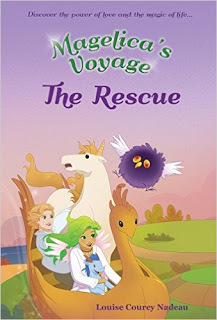 In Book One, Magelica’s Voyage, Magelica travelled to The Land of Two Suns with her pet dragon, Tris, and met Queen Raya, ruler of the Isle of Dreams. She was able to help Turtle, the turtle upon whose back the island rests, get started swimming again, so that the people could keep a lookout for Prince William who was feared to be lost at sea. In
The Rescue
(Magelica’s Voyage, Book 2) we catch up with Magelica as she is drifting off to sleep, nice and comfy in her warm bed, with Tris snuggled next to her. However, Prince William is having a terrible time. He and his goldaron, Goldy, are forced to abandon ship when their ship is wrecked on some rocks. They manage to get to the safety of land, but what a horrible, dark and dreary place it is, filled with fog, gloom, and strange noises coming from the forest. How will they be found? Meanwhile Magelica has a dream that convinces her she has to get to Queen Raya right away to help save Prince William. Can Magelica lead the inhabitants of the Isle of Dreams to save their prince? Is her imagination and belief powerful enough to overcome any setbacks?
In Book One, Magelica’s Voyage, Magelica travelled to The Land of Two Suns with her pet dragon, Tris, and met Queen Raya, ruler of the Isle of Dreams. She was able to help Turtle, the turtle upon whose back the island rests, get started swimming again, so that the people could keep a lookout for Prince William who was feared to be lost at sea. In
The Rescue
(Magelica’s Voyage, Book 2) we catch up with Magelica as she is drifting off to sleep, nice and comfy in her warm bed, with Tris snuggled next to her. However, Prince William is having a terrible time. He and his goldaron, Goldy, are forced to abandon ship when their ship is wrecked on some rocks. They manage to get to the safety of land, but what a horrible, dark and dreary place it is, filled with fog, gloom, and strange noises coming from the forest. How will they be found? Meanwhile Magelica has a dream that convinces her she has to get to Queen Raya right away to help save Prince William. Can Magelica lead the inhabitants of the Isle of Dreams to save their prince? Is her imagination and belief powerful enough to overcome any setbacks?Once again, enchanting illustrations form an integral part of the charm of this book series by Louise Courey Nadeau, and are certain to captivate young readers and their parents. Detail and colour make the images come to life and even tell the story on their own. Familiar characters from Book One appear again which will delight young fans. Of course Odin the warblegrif can’t be left out of any action and Wally the Wizard just wants to get his magic working again. The subtle empowering messages of Book One are amplified here, with songs and end notes to encourage young readers to make their lives magical and to enjoy the positive power of laughter. When Magelica truly believes, trusts, and lets go, she is able to do amazing things, and young readers (and adults!) will benefit from these simple truths. The power to achieve whatever we want is within us, and Magelica’s example helps young readers to believe in themselves and go where life takes them. This is a five-star read for the whole family!
Published on October 31, 2015 05:27
October 26, 2015
Book Review: Patch Goes to London
 Patch goes to London by Anjalique Gupta is the adorable story of a very clever little Jack Russell called Patch, and his adventures in London. He has a very loving mom who absolutely dotes on him. They live in India. On his collar, Patch notices a shiny gold thing, a key, and he wonders what it is for. His mom tells him he’ll find out soon enough when his first birthday arrives. Patch can hardly wait because his first birthday is almost here! His friends give him lovely gifts but Patch is eager to see his birthday surprise. The postman delivers a parcel that has come all the way from the United Kingdom. Inside is a wooden chest and, at his mom’s suggestion, Patch uses the key to open it. Wow! What a surprise. Inside he finds a pet passport (with his name on it!) and an air ticket to London. It’s all a big mystery but by going to London, Patch will be able to piece together the clues as they unfold in an absolutely amazing adventure. Join Patch as he collects clues and finds out some incredible news at the end of his adventure.
Patch goes to London by Anjalique Gupta is the adorable story of a very clever little Jack Russell called Patch, and his adventures in London. He has a very loving mom who absolutely dotes on him. They live in India. On his collar, Patch notices a shiny gold thing, a key, and he wonders what it is for. His mom tells him he’ll find out soon enough when his first birthday arrives. Patch can hardly wait because his first birthday is almost here! His friends give him lovely gifts but Patch is eager to see his birthday surprise. The postman delivers a parcel that has come all the way from the United Kingdom. Inside is a wooden chest and, at his mom’s suggestion, Patch uses the key to open it. Wow! What a surprise. Inside he finds a pet passport (with his name on it!) and an air ticket to London. It’s all a big mystery but by going to London, Patch will be able to piece together the clues as they unfold in an absolutely amazing adventure. Join Patch as he collects clues and finds out some incredible news at the end of his adventure.This is a truly wonderful book for young readers to either read by themselves or enjoy reading with a parent or grandparent. Patch’s cute character is based on a real dog, owned by the author, and he has been lucky enough to travel the world with his human mom. The illustrations by Alexandra Gold on each page are just enchanting and make the book into a vivid adventure for young readers. I loved all the details on each page, which will definitely get kids and parents looking up more about each famous landmark where Patch receives yet more clues. The canine characters that give Patch each new clue are too cute for words and every dog is a different breed, adding more interest for young readers who love animals. The good news is that this is just the first of Patch’s adventures in globe trotting. I wonder where Patch will go next. At the end of the book, young fans can keep up with Patch on his Facebook page and Instagram, where no doubt he’ll drop hints about his next destination. A really lovely read that kids will return to time and time again.
Published on October 26, 2015 00:29
October 20, 2015
The Legend of the Scarab King
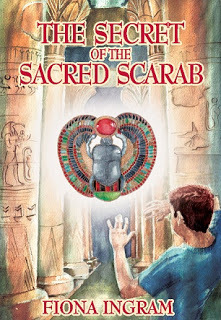 I have often been asked if the Scarab King, the foundation character of Book 1: The Secret of the Sacred Scarab is based on a real person. In ancient Egyptian pre-history, two centers of civilization developed: one in the north, around the Nile Delta, (Lower Egypt) and the other in the Nile Valley, to the south (Upper Egypt). Before the unification of Egypt in 3100 BC, the area was divided into small chiefdoms, each ruled over by a king, who was generally the leader of his tribe. The ancient Egyptians did not call the kings of Egypt ‘pharaohs.’ This word was used by the Greeks and Hebrews, and today is commonly used to denote the ancient kings of Egypt. At various times in its ancient past, the country was split up and there were at least several kings ruling different areas at the same time. There were also probably kings who ruled regions of Egypt before recorded history, and in fact, several ancient historians mention legendary kings who were elevated to the status of Egyptian gods. I’ve based my legend of the Scarab King on an idea of what a king of that time may have been like.
I have often been asked if the Scarab King, the foundation character of Book 1: The Secret of the Sacred Scarab is based on a real person. In ancient Egyptian pre-history, two centers of civilization developed: one in the north, around the Nile Delta, (Lower Egypt) and the other in the Nile Valley, to the south (Upper Egypt). Before the unification of Egypt in 3100 BC, the area was divided into small chiefdoms, each ruled over by a king, who was generally the leader of his tribe. The ancient Egyptians did not call the kings of Egypt ‘pharaohs.’ This word was used by the Greeks and Hebrews, and today is commonly used to denote the ancient kings of Egypt. At various times in its ancient past, the country was split up and there were at least several kings ruling different areas at the same time. There were also probably kings who ruled regions of Egypt before recorded history, and in fact, several ancient historians mention legendary kings who were elevated to the status of Egyptian gods. I’ve based my legend of the Scarab King on an idea of what a king of that time may have been like.“Many thousands of years ago, long before the time of the great pharaohs, the gods walked with men on earth. It was a time that has long been forgotten. In the ancient land of Kemet, there lived a wise and good king. He was a humble man who looked to the earth and nature, the birds, beasts, and insects for inspiration on how to rule with wisdom and skill. He searched for a creature as his totem; a creature that would be a sacred symbol of his kingship and his beliefs. But what to choose, he wondered. There were already so many royal symbols: the serpent, the lion, the falcon, the scorpion, the sun …
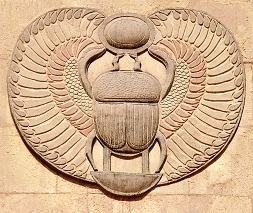 The king was baffled. He had no answer. One day, against the counsel of his advisors and courtiers, he walked out alone into the desert. He believed an answer would come to him there in that vast expanse of sun and sand. After a few hours of walking, he became hot and tired, and regretted his decision. He sat down and just watched the scenery around him. Movement in the sand next to his sandal caught his attention. An insignificant black insect, a scarab beetle, scurried past him, rolling a ball of dung in which to lay its eggs.
The king was baffled. He had no answer. One day, against the counsel of his advisors and courtiers, he walked out alone into the desert. He believed an answer would come to him there in that vast expanse of sun and sand. After a few hours of walking, he became hot and tired, and regretted his decision. He sat down and just watched the scenery around him. Movement in the sand next to his sandal caught his attention. An insignificant black insect, a scarab beetle, scurried past him, rolling a ball of dung in which to lay its eggs.“Khephri! The sacred scarab and god of the rising sun,” said the king. “The giver of new life and the symbol of the sun’s rebirth each day after the blackness of night.”
He chose this beetle, so humble and yet so vital in the Egyptian circle of life and mythology, as his totem, his symbol. He made the name Khephri part of his own name and had images of the sacred scarab carved onto the temple walls. Then he commanded his royal goldsmith to fashion a magnificent scarab from gold and jewels to hang around his neck. In the middle of the scarab, the jeweller placed the First Stone of Power, given to the king by the Seven Sages to help him rule wisely and well. The king became known thereafter as the Scarab King.
The king was tall, strong, and handsome. He loved to hunt. He was an excellent sportsman and a wonderful king. His people loved and admired him. Under his reign, the kingdom prospered. People were well fed, employed, and enjoyed their lives. The king married a beautiful girl but, sadly, they had no children. He had a stepbrother, Seti, who took his name from the dark god of chaos and storms, the god Set. Seti was the opposite of his handsome stepbrother who worshipped the sun god, Ra.
Seti was jealous of his stepbrother. He wished to rule in his brother’s place. One problem stood in his way. According to custom, in order for a succeeding king to take up his rightful place on the throne, a secret ceremony was held between the old king and his appointed heir or successor. The new king would receive special instructions: magical chants, particular hand signals, and other aspects of the mystic rituals that passed from king to king. Then the priests would know that the new king was a genuine successor, and not a pretender to the throne.
Seti needed to know the secret rituals. When he asked his stepbrother about them, the Scarab King replied, “Ah, Seti, why do you pester me with these questions? Why do you ask for what cannot be given? You will never rule after me because you do not share my beliefs in life. You think only of yourself when a king must think of his people first. Do not ask me these questions again! I have chosen my cousin on my mother’s side to succeed me. Senreset is a good and wise man. He will make an excellent ruler.”
Seti seethed with anger as the king dismissed him from the royal chambers. Once he knew the secret words and signals, the kingdom would be his.
Of course, the chicken-hearted priests will accept me, he thought. They believe in the ritual. I believe in the power. Once I am king, I will have the First Stone of Power, and then my control over the kingdom will be complete.
He sent his men to bribe the High Priest to reveal the secret rituals, but the man refused. Seti tried three times, but each time the High Priest sent them away. Seti was so angry that he ordered his men to slay the High Priest. However, his men were afraid of the wrath of Ra, and they disobeyed. Finally, Seti went himself to the High Priest. Although the man trembled before the king’s stepbrother, he would not reveal the sacred secrets of the rituals of kingship. Seti knew that the Scarab King, being healthy and strong, would live for many years. There was only one thing left to do: he must kill the king! He lured his stepbrother into a lonely part of the palace, under the pretext of discussing building plans. Then, when diagrams that Seti had brought along distracted the king, Seti struck him down.
The king fell to the ground, bleeding from the fatal blow. As the king lay dying, he groaned and grasped Seti by one hand. “You will never find it, my brother, and you will not be king for long. Your heart will be weighed on the Great Scales and you will be found lacking.”
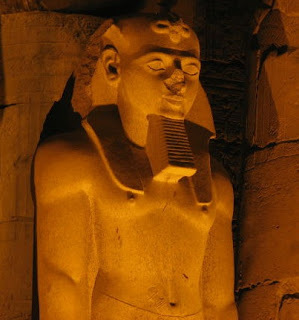 Seti, frightened by these words, felt under the king’s tunic for the scarab. It was not there. Seti shrieked for his men and, within minutes, they had overrun the palace. Seti questioned the king’s priests closely, threatening them with torture, but they pretended not to know where the sacred scarab and the king’s regalia were kept. They also denied knowing the magic words of the ritual. Seti cursed the heavens and the gods for defeating his plans. His screams rose skyward and the city trembled beneath his wrath. The Secret of Power had gone with the king to his grave. However, Seti thought that when the king was buried, one of his priests would place the scarab in the king’s sarcophagus according to custom. If he could find the scarab, he could try to turn its power to his purposes.
Seti, frightened by these words, felt under the king’s tunic for the scarab. It was not there. Seti shrieked for his men and, within minutes, they had overrun the palace. Seti questioned the king’s priests closely, threatening them with torture, but they pretended not to know where the sacred scarab and the king’s regalia were kept. They also denied knowing the magic words of the ritual. Seti cursed the heavens and the gods for defeating his plans. His screams rose skyward and the city trembled beneath his wrath. The Secret of Power had gone with the king to his grave. However, Seti thought that when the king was buried, one of his priests would place the scarab in the king’s sarcophagus according to custom. If he could find the scarab, he could try to turn its power to his purposes.But the king’s loyal followers prepared his body, placing it in a sarcophagus of solid gold, and transported it at night, along with all the treasure, to a secret tomb so that none would violate it. They descended into the entrails of the earth and hid the body in the Place of Divine Inundation, protecting it with magical incantations. The Scarab King, like the sacred scarab, returned to the earth, later to rise in the sky as a star.”
If you’re looking for more adventures, then please visit The Quest Books, where Middle Grade authors Cheryl Carpinello, Wendy Leighton-Porter and I have teamed up to offer readers an array of exciting quests. Sign up for our monthly newsletter with exciting exclusive material and get your choice of any e-book on the site FREE!
Published on October 20, 2015 04:42



